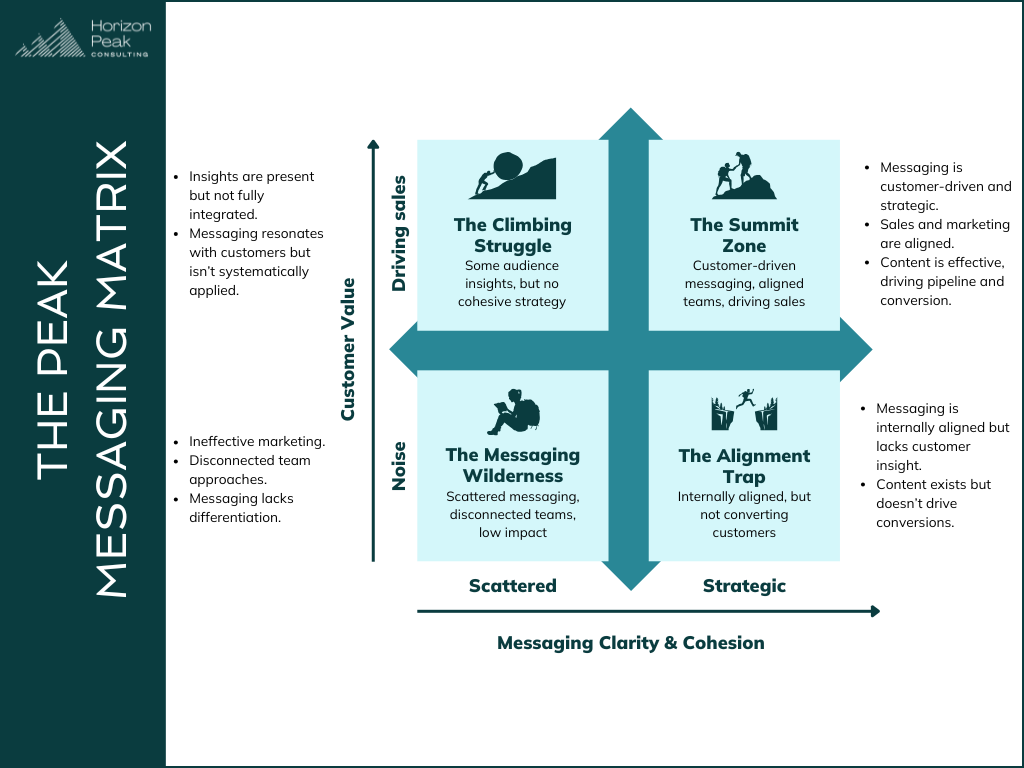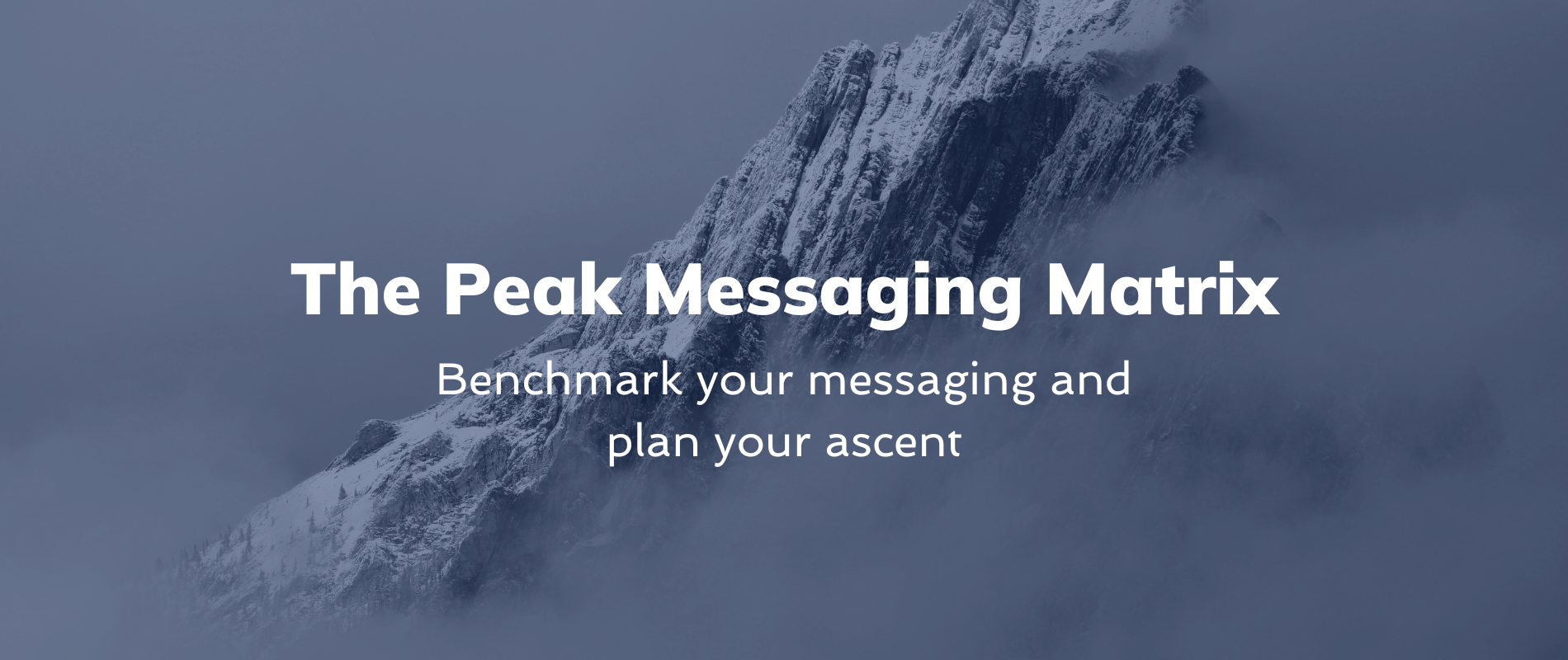Your sales team is spending precious customer time explaining how your solution is different from your competitors’. You put your company website up on screen in a packed room at a conference, and the people in the front row can’t figure out what you’re selling. Your marketing team is using completely different language in their collateral than the sales team is using with customers on the phone.
You’ve got a messaging problem.
You’ve got more competition than ever before, your customers are in no hurry to spend their money, and the buying process is ridiculously complex — which means you have to get in front of, be memorable for, and convert a wide array of people over a long period of time.
If you’ve got a messaging problem, you’ve got a sales problem.
But messaging — how you communicate what you offer, what you stand for, how you’re different, and how you solve your customer’s problem — isn’t just about choosing juicy adjectives.
It’s not even about words.
Messaging is about forging a connection.
Connecting your solution to what’s keeping your customer up at night.
Connecting your company to something the audience already cares about.
Connecting the humans at your company to the humans you’re trying to reach.
Because of this, messaging should not come from you.
Messaging is about them
Startup founders have earned the right to have strong opinions about their messaging. It’s their blood, sweat and tears that got the company to where it is today.
Founders know the competitive landscape, and they know their market.
And more than likely, they’re still doing a lot of the heavy lifting with sales — so they are deeply in touch with the audience they’re trying to reach.
Because of this hard-won expertise, a lot of founders think they know exactly what messaging is going to resonate with the audience.
Unfortunately, they’re often wrong … and it’s because they’re so entrenched.
As one of my startup founder clients put it, they’re “too close to their own stuff.”
And frankly, while they may be asking the right questions for sales, they’re not asking the right questions for good messaging.
What is good messaging?
Good messaging gets to the heart of the customer. It begins to forge connection from the moment the customer first encounters your company. It’s sticky, it’s differentiated — but most importantly, it’s meaningful to the people who matter.
Tactically, good messaging …
- Uses customer language exactly.
- Prioritizes the same things the customer prioritizes.
- Is clear always and clever strategically.
- Goes deep enough to effectively drive content and campaign decisions.
- Is consistent across the organization — every team works off the same playbook.
This is why I advise clients to stop making up their own messaging, and start listening to the audience more closely.
Your customers will tell you exactly what messaging will have resonance and meaning for them, what messages will build trust, and what messages will convince them to take the next step with your solution.
But getting this insight is only the first step. Then you have to operationalize it.
The Peak Messaging Matrix
Getting to an effective messaging strategy is not rocket science — but it does take planning and know-how.
The Peak Messaging Matrix below will reveal where you are on the spectrum of messaging effectiveness. It shows you the levers to pull that will make your messaging resonant for your customers, and productive for your marketing and sales teams.

The Messaging Wilderness
This is where most startups begin. They’ve got messaging and content — but it’s not really doing anything for them or their target customers. Different teams and individuals within the startup are using different messaging, and none of it is informed by the audience.
The Climbing Struggle
When a startup begins to gather customer and target audience insight, they start seeing more traction with their messaging and content. But without integrating that insight into a clear cross-functional messaging strategy, that traction isn’t consistent, because it’s still not a cohesive effort within the company. Think of it this way: Instead of flying in a V formation, you’ve got geese flying every which way.
The Alignment Trap
Of course, you’ve got a different problem when your people are aligned behind a messaging strategy, but that strategy isn’t informed by customer insights. In this case, your geese are flying in formation — they’re just flying in formation going the wrong direction. When your messaging is clear and cohesive across your organization, that’s great for operational efficiency — but it won’t help with conversion until the customer is reflected in that messaging.
The Summit Zone
To drive pipeline and conversion, a startup needs to get to the Summit Zone. This is where the messaging and content are informed by customers and cohesive across sales and marketing. This is where your content works. Customers are moved to action, marketing is delivering highly qualified leads to the sales team, and the sales team is closing customers with much more ease.
“The campaign not only revived a lapsed opportunity, it also led to the customer DOUBLING the subscription and the number of seats they had originally wanted.”
Stephanie Webber
Marketing lead, revVana
(read more)
Summit bound: Where do we go from here?
I’m not going to tell you there’s a magic bullet for getting to the Summit Zone. It takes conversations, asking the right questions, digging deep into specific audience language, and looking at the data through different lenses.
But it’s possible for any startup that has achieved product-market fit.
And with the right partner, it doesn’t take a huge amount of time to go from the bottom of the mountain to that glorious summit.
Before, I had a lot of doubts in our marketing execution. I felt like we were coming up short before we even began. Now I’m so much clearer on our ideal customer, how they think, what’s important to them, and what they really want from us — and we have a strategic marketing plan that I’m 100% confident in. Our new marketing plan just FEELS so much better to me!
Erin Koss
CEO, Syte Consulting Group
(read more)
At Horizon Peak Consulting, I’ve been developing customer-centered marketing strategies for B2B startups for over a decade. We’re the OG content firm for startups that want to grow fast — not fail fast.
When you’re ready to ascend to messaging and content that actually drive sales, I’d love to have a conversation. Our proven methodology, The Summit Strategy Framework, will take you right where you need to go. Schedule a complimentary consultation right here.
